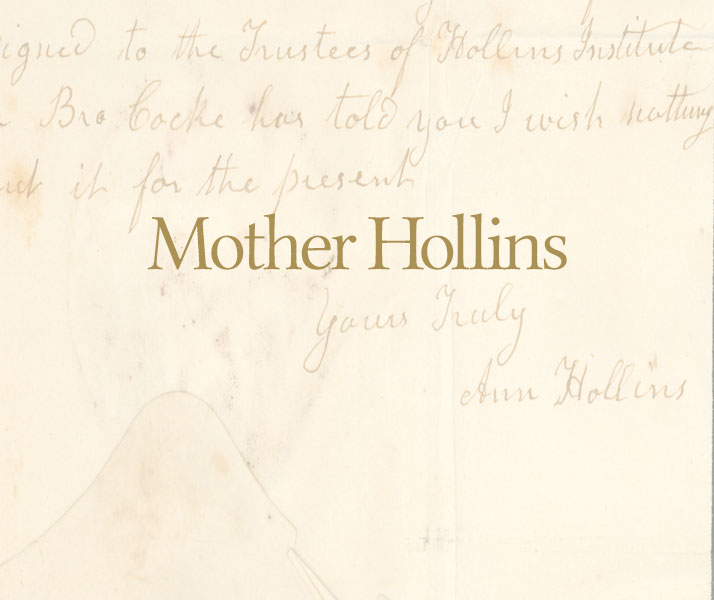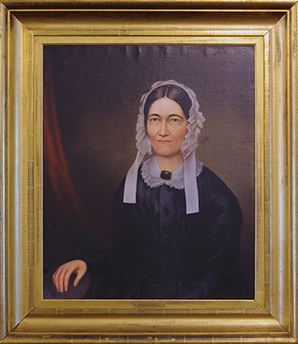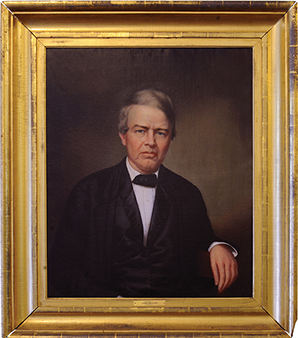
Mother Hollins
Ann Hollins took an early interest in the Female Seminary at Botetourt Springs, and the generosity she and her husband, John, showed the struggling school changed its name and its future.
By Brenda McDaniel
 Ann Hollins wasn’t keen on having her name attached to a college. After all, as her obituary would note a few years later, she was a woman known for her “liberality without ostentation.”
Ann Hollins wasn’t keen on having her name attached to a college. After all, as her obituary would note a few years later, she was a woman known for her “liberality without ostentation.”
But the Hollins trustees insisted this was the most appropriate way to recognize 60-year-old Ann Hollins and her husband, John, whom she had just talked into giving $5,000 to the Female Seminary at Botetourt Springs. The year was 1855. That gift—worth around $139,000 in current dollars—was the first large gift the school of approximately 123 young female students had ever received, and it probably kept the constantly financially strapped institution from going under. Acting on their gratitude, the trustees also offered John a seat on the board, which he accepted and held until his death in 1859.
While it was Ann who persuaded John to give the women’s school the first $5,000, and an additional $12,500 over their lifetimes, it undoubtedly was the school’s founder, Charles Lewis Cocke, who tapped his friends first and cultivated their interest. Cocke’s and Ann’s families had been associated with each other for years through Baptist church work in Eastern Virginia, where both were from.
Ann Halsey married John Hollins in 1811 in Richmond, and they moved to Lynchburg in 1817. In Lynchburg, John quickly became a wealthy and influential landowner, businessman, miller, grocer, and city liquor inspector. Ann became an active charter member of the First Lynchburg Baptist Church. She was the first president of the church’s Ladies Aid Society, serving until 1864. She also persuaded John to give generously to her church, although he never joined.
The History of the First Baptist Church of Lynchburg states: “To the question ‘What induces you to help the church so much if you do not love the Savior?’ John replied, ‘I suppose it must be to please my wife.’”
In addition to receiving gifts from Ann and John, evidence suggests the trustees also borrowed from the couple on occasion. In the university archives are two promissory notes to repay John Hollins signed by Hollins Institute trustee George P. Tayloe, dated November 12, 1857, for the amount of $623.78, and November 29, 1857, for $1,826.22. No record could be found to indicate whether the loans were repaid before John’s death on April 7, 1859.
 Although quite wealthy at the time of John’s death, neither John nor Ann left money to Hollins in their wills. John left “my manufacturing mill called the Blackwater Mill” to Ann when he died on the eve of the Civil War. Ann lost most of her fortune, a reported $140,000 in invested funds, in the war. When she died, in 1866, she bequeathed the portraits of herself and John that had hung in her parlor to Hollins Institute, as the trustees had wanted her to do.
Although quite wealthy at the time of John’s death, neither John nor Ann left money to Hollins in their wills. John left “my manufacturing mill called the Blackwater Mill” to Ann when he died on the eve of the Civil War. Ann lost most of her fortune, a reported $140,000 in invested funds, in the war. When she died, in 1866, she bequeathed the portraits of herself and John that had hung in her parlor to Hollins Institute, as the trustees had wanted her to do.
With the passing of Ann and John Hollins, Charles Cocke lost not only old and dear friends, but also generous donors (he once said Ann would have given more had she not lost her fortune in the war) and supporters who believed in his mission to educate women. Of course, whether John was as passionate about the mission as his wife and Cocke were is not known. It may be that he gave to Cocke’s institution for the same reason he supported the Baptist church: to please his wife. Regardless, the fact that he so generously backed his wife’s interests says as much about his character as it does about hers.
No, they didn’t found Hollins, as people unfamiliar with our history often assume. But they found a reason to keep it alive during those tenuous early years. And while Ann Hollins never had children of her own, every woman who has ever attended Hollins Institute, Hollins College, and Hollins University can rightly call her Mother Hollins.
Brenda McDaniel HON ’12 served as Hollins’ executive director of donor relations before her retirement in 2013. Thanks to Beth Harris, special collections and government information librarian. The portraits of Ann and John Hollins hang in the Green Drawing Room in Main.
